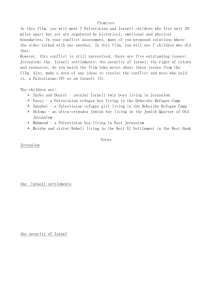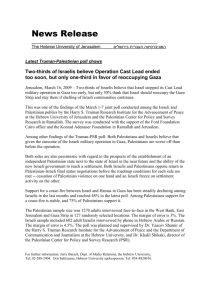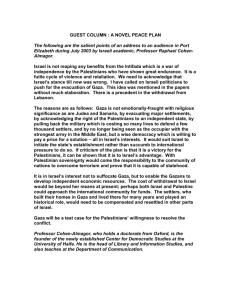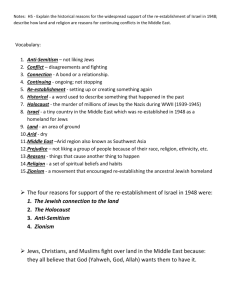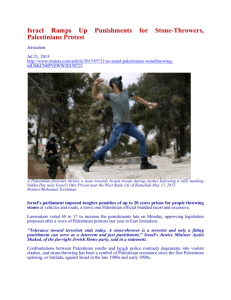History of the Arab-Israeli Conflict in Maps
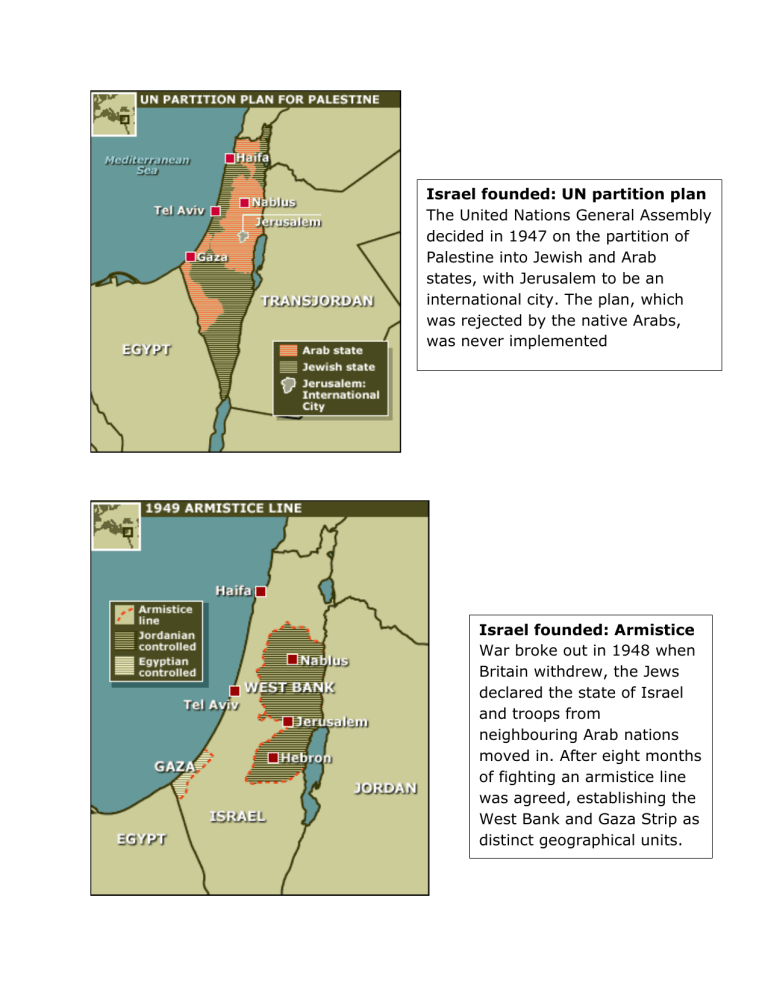
Israel founded: UN partition plan
The United Nations General Assembly decided in 1947 on the partition of
Palestine into Jewish and Arab states, with Jerusalem to be an international city. The plan, which was rejected by the native Arabs, was never implemented
Israel founded: Armistice
War broke out in 1948 when
Britain withdrew, the Jews declared the state of Israel and troops from neighbouring Arab nations moved in. After eight months of fighting an armistice line was agreed, establishing the
West Bank and Gaza Strip as distinct geographical units.
Six-Day War: Before the war
From 1948 to 1967, the West
Bank, including East Jerusalem, was ruled by Jordan. During this period, the Gaza Strip was under
Egyptian military administration.
Israeli troops captured Egypt's
Sinai peninsula during the 1956
British, French and Israeli military campaign in response to the nationalisation of the Suez Canal.
The Israelis subsequently withdrew and were replaced with a UN force. In 1967, Egypt ordered the UN troops out and blocked Israeli shipping routes - adding to already high levels of tension between Israel and its neighbours.
Six-Day War: After the war
In a pre-emptive attack on Egypt that drew Syria and Jordan into a regional war in 1967, Israel made massive territorial gains capturing the West Bank, Gaza Strip, Golan
Heights and the Sinai Peninsula up to the Suez Canal. The principle of land-for-peace that has formed the basis of Arab-Israeli negotiations is based on Israel giving up land won in the 1967 war in return for peace deals recognising Israeli borders and its right to security. The Sinai
Peninsula was returned to Egypt as part of the 1979 peace deal with
Israel.
Jerusalem: Before 1967
The armistice line drawn at the end of the 1948 war divided
Jerusalem into two. Between
1949 and 1967, Israel controlled the western part of Jerusalem, while Jordan took the eastern part, including the old walled city containing important
Jewish, Muslim and Christian religious sites.
Jerusalem: After 1967
Israel captured the whole of
Jerusalem in 1967 and extended the city's municipal boundaries, putting both East and West Jerusalem under its sovereignty and civil law.
In 1980 Israel passed a law making its annexation of East Jerusalem explicit. The city's status remains disputed, with Israel's occupation of
East Jerusalem considered illegal under international law. Israel is determined that Jerusalem be its undivided capital, while Palestinians are seeking to establish their capital in East Jerusalem.
West Bank: Palestinian-
controlled areas
Since the 1993 Declaration of
Principles resulting from the Oslo peace process, there have been several handovers of land to differing degrees of Palestinian control. Currently 59% of the West
Bank is officially under Israeli civil and security control. Another 23% of it is under Palestinian civil control, but Israeli security control.
The remainder of the territory is governed by the Palestinian
National Authority - although such areas have been subject to Israeli incursions during the recent intifada.
West Bank: Population centres
The areas of Palestinian Authority control are mainly located in
Palestinian urban areas – the population centres where much of the fast-growing population lives.
These take up about 8.5% of the
West Bank. About 2.3 million
Palestinians live in the West Bank, together with about 400,000
Israeli settlers - including those who live in East Jerusalem. About
6.7 million people live in Israel, of whom about 1.3 million are Israeli
Arabs.
West Bank: Israeli
settlements
Since 1967, Israel has pursued a policy of building settlements on the West Bank. These cover about 2% of the area of the
West Bank and are linked by
Israeli-controlled roads. There are also large tracts of Israelicontrolled land designated as military areas or nature reserves.
West Bank: Israeli checkpoints
Military checkpoints on West Bank roads allow Israel to monitor and control travel in much of the West
Bank. During the recent Palestinian intifada, Israeli troops have also encircled and staged incursions into population centres and severely restricted the movement of Palestinian civilians. In 2002, Israel began building a security barrier near the northwestern edge of the West Bank.
Gaza Strip: Population
Gaza, one of the most densely populated tracts of land in the world, is home to about 1.3m
Palestinians, about 33% of whom live in United Nations-funded refugee camps. About 8,000
Jewish settlers also lived in the
Gaza Strip until September 2005 when they and the troops that protected them were withdrawn.
Before the withdrawal, travel in and out of Gaza was severely restricted for long periods.
Gaza Strip: Access and security
Israel controls Gaza's airspace, coast and most of its borders. In
November 2005 Israel agreed to allow the Palestinians and Egypt to control the Rafah crossing point
(with video surveillance by an EU-
Palestinian team), and to increase traffic through Erez and Karni crossing points. The construction of a sea port was also given the goahead. The future of Gaza's destroyed airport is yet to be agreed.

